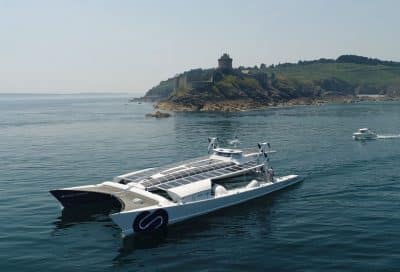Since this summer, the Energy Observer, a solar-wind-hydrogen catamaran, has been roaming the seas. After nearly four years of preparation, the ship was christened in July and the crew could set off on their journey. The initiators of the project plan to be at sea for nearly six years and stop in around 50 countries to inform about renewable energies, showcase sustainable technologies and demonstrate their potential. The focus is on energy autonomy.
The idea for the journey was born in 2013 when Frédéric Dahirel approached Victorien Erussard, an officer in the navy and a frequent participant in regattas, about the design of a solar-powered catamaran. This prompted Erussard to buy a racing boat that had won the Jules Verne Trophy in 1994 for EUR 500,000 together with Jérome Delafosse and hire a crew.
Meanwhile, the team of seafarers, designers and engineers has grown to 50 and Erussard is now captain of the Energy Observer. Delafosse, a filmmaker and diver, was appointed expedition leader. Funding came primarily from Nicolas Hulot, France’s new environment minister and president of the Foundation for Nature and Mankind, and Florence Lambert, managing director of CEA-LITEN, the Innovation Laboratory for New Energy Technologies and Nanomaterials.
Solar, wind and hydrogen
One of the first tasks of the crew was to turn the racing boat in Saint-Malo, France, into a solar-powered catamaran. Originally 24.4 meters or 80.1 feet long and 12.8 meters or 50 feet wide, it was ultimately extended to 30.5 meters or 103.3 feet and the sails were replaced with PV modules, wind turbines and an electrolyzer combined with a fuel cell system.
In addition to the 21-kilowatt solar cells measuring 130 m2, the 30-ton ship was equipped with two vertically installed wind turbines of 1 kW capacity each and a towing kite. The latter is thought to reduce energy demand and – at optimal orientation – make power generators out of the 41-kilowatt electric motors. The created eco-power will be used in the onboard electrolyzer to produce hydrogen from saltwater at 4 normal cubic meters per hour, which is why the ship also has a desalination unit based on reverse osmosis.
The H2 gas will leave the electrolyzer at 30 bars or 435 psi, be compressed to 350 bars or around 5,000 psi and stored temporarily in two pressure vessels that each can hold 4,322 liters (= 62 kilograms) to supply the 22-kilowatt fuel cell at nighttime or when the wind isn’t blowing. The two hulls contain 106-kilowatt-hour lithium-ion batteries to provide electricity at 24, 220 and 400 volts. Average hourly speed is projected to be 15 to 19 kilometers or 9 to 12 miles (at a maximum 78 kilometers or 48 miles per hour).
A journey for the future
The first time the boat was put into water was on April 14, 2017. Captain Erussard showed up only shortly before the launch, as his second son was born the same day. He said: “Watching the ship touch down in the water for the first time was an exhilarating moment. From now on, we will all begin testing these new technologies, especially the electrolyzer and the fuel cell.” Delafosse added: “It was a unique and emotionally overwhelming experience. The launch will mark the start of our odyssey into the future.”
“This project reflects the changes that need to happen on a global scale.”
Nicolas Hulot, a sponsor of the Energy Observer
From their home port in the French Bretagne region, Dahirel and Erussard set off for Paris at 8 a.m. on June 26. On July 4, the adventurers reached France’s capital, where the Energy Observer was christened two days later by its sponsors, Hulot and Lambert. Others in attendance were the mayor of Paris, Anne Hidalgo and Bertrand Piccard, adventurer and president of the Solar Impulse Foundation.
The crew anchored in Paris until July 15, after which they made another stop in Boulogne sur Mer before they had to return home for a “quick fix,” as they put it. In late August, they continued with their own “Tour de France” to Cherbourg-en-Cotentin, Nantes and Bordeaux. Their subsequent goal is to reach the Mediterranean Sea and potentially make a stop in Hamburg, but presumably not before 2019. There will reportedly be more than 100 stops during the entire journey, which has been broadcasted live over the internet since Day 1 and can be tracked online.
In comparison: solar catamaran
The MS Turanor PlanetSolar made it around the world in 585 days from 2010 to 2012. Back then, the weight of the batteries alone added up to 11 tons, and while both ships are comparable in size, the Turanor weighed nearly three times as much as the Energy Observer.
Bertrand Piccard
The Energy Observer project was inspired by Bertrand Piccard’s and André Borschberg’s journey around the world in their electricity-powered aircraft. Named Solar Impulse 2, it had around 17,000 solar cells, four electric motors, a wingspan of 72 meters or 236 feet and an average speed of 58 kilometers or 36 miles per hour. Piccard and Borschberg took off from the capital of the United Arab Emirates, Abu Dhabi, in March 2015 and returned on July 26 last year. It took them nearly 510 hours to fly 40,000 kilometers or 24,855 miles based on solar energy only. Their late touchdown was caused by a battery failure, which forced them to wait nine months until they could resume their flight. Still, Ban Ki Moon, then secretary general of the UN, congratulated them on their achievement and said: “It was a historic day for humanity.” Piccard might be ending his journey, he added, “but the journey to a sustainable world is just beginning.”
http://energyobserver.geovoile.com/tourdumonde/2017/tracker/?lg=en


























0 Comments